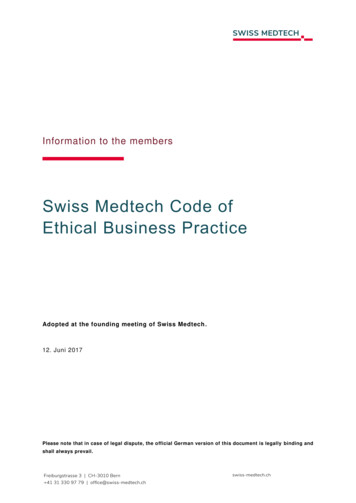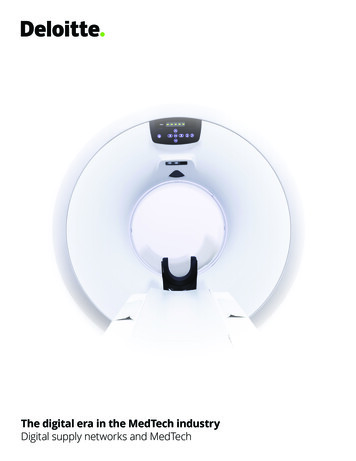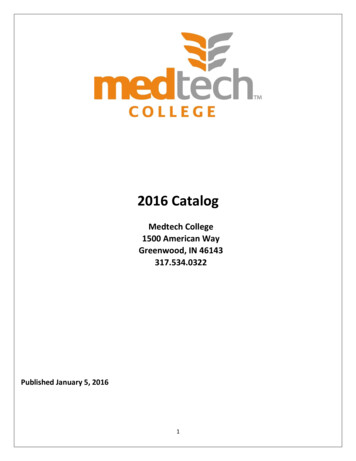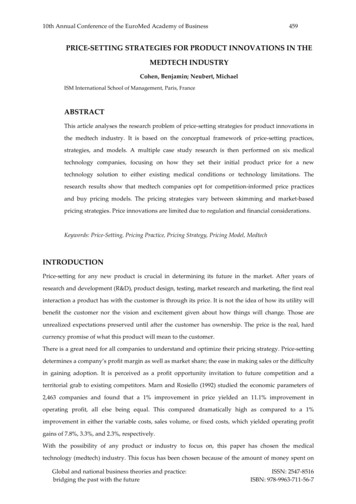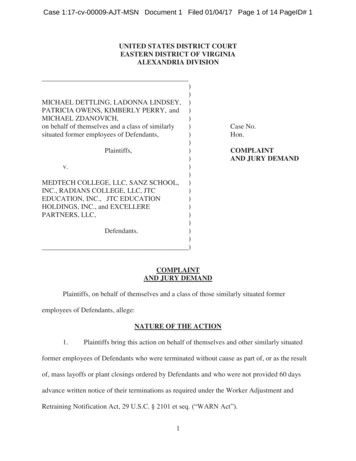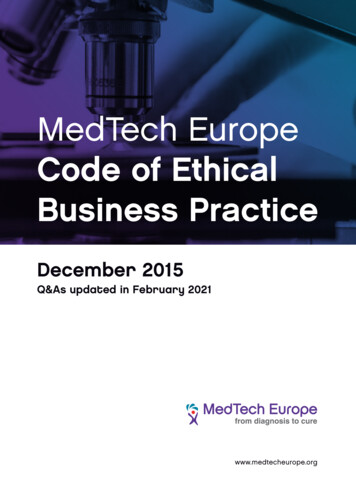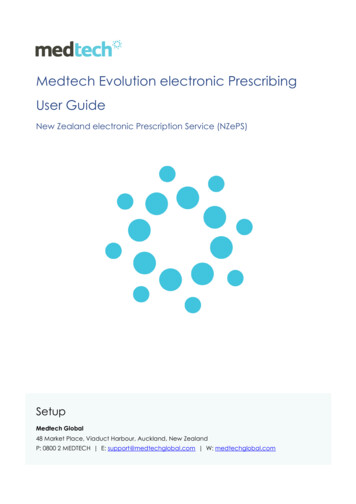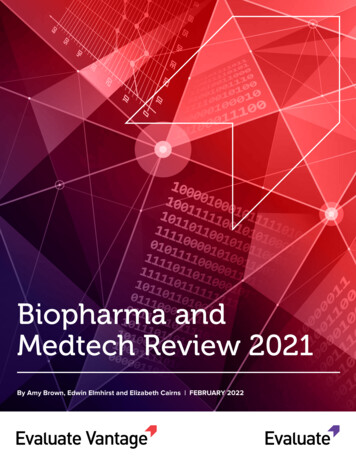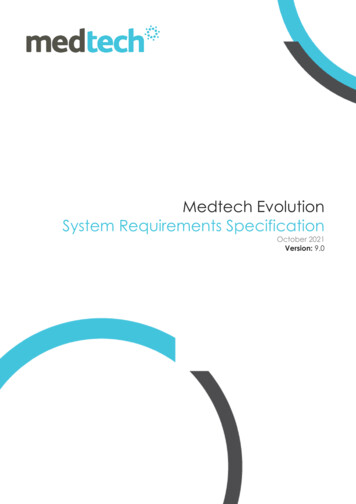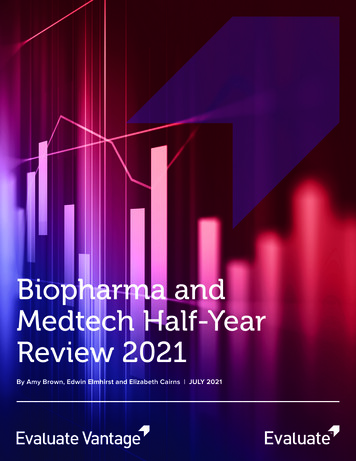
Transcription
Biopharma andMedtech Half-YearReview 2021By Amy Brown, Edwin Elmhirst and Elizabeth Cairns JULY 2021
ForewordThe pandemic is far from over, but for many in biopharmabusiness returned to almost normal in the first half of 2021.Companies are successfully operating remotely, deals are gettingdone, and clinical research has largely recommenced, aside fromareas involving patients particularly vulnerable to Covid-19.Developers that brought pandemic treatments or vaccines to market are busy reaping the benefits – those thatchose to profit, at least. Concerted industry-wide efforts to find novel ways to supress the viral disease have ebbedto small pockets of discovery work.The flood of public investors taking defensive positions in the sectors that came to the world’s aid last year hasalso receded. This meant that certain drug and medtech indices had not performed as strongly as some others atthe half- year stage. But with global interest rates at record lows growth stocks remain in demand, and developerswith a strong story to tell have benefited in particular.Moderna, riding high on the success of its mRNA Covid-19 vaccine Spikevax, is the standout example in biotech.The largely research-stage company’s market cap touched an unfathomable 196bn in early August, making thegroup worth more than established big pharma players Astrazeneca and Bristol Myers Squibb.Winners and losers are just as clearly delineated in medtech. In a reversal of fortune from this time last year,companies producing tests for Covid-19 or the ventilators and other technologies used to treat patients with thedisease have lost ground. Those making devices used in orthopaedics or cardiovascular procedures, for instance,are surging back as non-urgent procedures start back up with a huge backlog to get through.Unjustifiable valuations in both biotech and medtech are not just confined to the stock market. Concerns aregrowing that the richly endowed venture capital industry is driving asset prices too high in the private sphere,particularly in competitive areas like oncology. A wide-open IPO window is helping the financing wheels turnquickly, by allowing these funds to flip early-stage developers rapidly into the hands of equity investors.These trends have caused record-setting numbers to emerge in the first half of the year, this report reveals.Biotech flotations raised 9bn, while private start-ups raised 15bn in venture cash, according to Evaluate Pharma.In medtech mergers are happening at a healthy pace, but a quiet six months for M&A in biopharma suggests thathigh valuations are having an effect on dealmaking.But biopharma remains a highly active in-licensor of innovation. For the first time this report contains insights fromBioSciDB, acquired by Evaluate earlier this year, revealing a busy licensing deal scene. Almost 6bn was spent onup-front fees in the first half, putting the year on track to match last year’s record, with price inflation also evident inthis dataset.This report is a combination of articles published by Evaluate Vantage examining the emerging trends shaping thebiopharma and medtech sectors. Read on for a deeper dive into the data, collated by Evaluate Pharma.Unless stated, all data are sourced to Evaluate and were accessed in July 2021.2Evaluate Vantage Pharma, Biotech and Medtech Half-Year Review 2021 Copyright 2021 Evaluate Ltd. All rights reserved.
ContentsBiopharma Half Year Review 2021Alzheimer’s and Covid-19 developers lead biopharma’s stock market gainers 4The financing boom continues for listing biotechs 10Venture investors still love drug developers 14Biopharma takeovers dry up but licensing deals still hot 16Outlook 21Medtech Half Year Review 2021Role reversal for large-cap medtechs 22Medtech gears up for a vintage acquisition year 25Medtech venture funding hits new heights 28Floating medtechs go big or go home 31The FDA takes its foot off the pedal 34Outlook 373Evaluate Vantage Pharma, Biotech and Medtech Half-Year Review 2021 Copyright 2021 Evaluate Ltd. All rights reserved.
Biopharma Half YearReview 2021Alzheimer’s and Covid-19 developers lead biopharma’s stockmarket gainersThe pandemic tide that lifted biopharma last year has receded, leaving developers that managed to bringCovid-19 treatments to market among the sector’s best performing stocks in 2021. Alzheimer’s diseaseplayers are also doing very well, thanks to the FDA’s controversial approval of Biogen’s Aduhelm, which isthought likely to open the gates to contenders coming behind.Relatively speaking, however, drug indices underperformed broader indices in the first half of 2021. Partlythis was because the reopening of Western economies prompted investors to flock back to industries mostdamaged by the outbreak of Covid-19, chasing recovery stories.Relative performance of selected drug indices YTD30%25%20%Index 1/03/04XBI (equal weighted)42021/04/04Drug indicesNBI2021/05/04S&P pharma indexEvaluate Vantage Pharma, Biotech and Medtech Half-Year Review 2021 2021/06/042021/07/04ComparatorsS&P 5002021/08/04DJIACopyright 2021 Evaluate Ltd. All rights reserved.
This is not to say that biopharma shares have disappointed – the Evaluate Pharma global drug stock universeput on 379bn in market cap across the first six months of the year. By comparison, half a trillion in value wasadded in 2020.This analysis tracks the stock market performance of just over 700 global biopharma groups covered byEvaluate Pharma; it includes only pure-play drug developers with a market capitalisation of more than 250mat the start of the year.The shifting valuations of global drug makers6000 5,195bn 52bnYE 2020 cohortQ1 2021 327bn 5,573bnQ2 20212021 YTDMarket cap ( bn)5000400030002000100005Evaluate Vantage Pharma, Biotech and Medtech Half-Year Review 2021 Copyright 2021 Evaluate Ltd. All rights reserved.
Huge gains from Eli Lilly and Roche account for more than half of the big pharma group’s market capexpansion over the six months. Hopes are high that their respective Alzheimer’s assets, donanemab andgantenerumab, will be launched sooner than anticipated.To construct this analysis companies in the Evaluate universe are split into the valuation brackets belowbased on their market cap at the end of 2020, and remain in that cohort throughout the year.Absolute market cap gains and losses, by market cap bracket200Market cap movement ( bn) 171bn150100 84bn 55bn50 35bn 23bn0 6bn 18bn- 12bnQ2 2021Q1 2021- 50Big pharma* 25bn 5bn- 25bn 250m- 5bn*Big pharma comprised of: Abbvie, Astrazeneca, Bristol Myers Squibb, Eli Lilly, Glaxosmithkline, J&J, Merck & Co, Novartis, Pfizer,Roche, Sanofi.6Evaluate Vantage Pharma, Biotech and Medtech Half-Year Review 2021 Copyright 2021 Evaluate Ltd. All rights reserved.
In the big cap cohort the company that started the Alzheimer’s renaissance, Biogen, was outdone byModerna.Indeed much of the universe’s gains over the first half of the year are derived from a small group of verystrong performers among the larger developers. This became particularly apparent in the second quarter,with smaller developers performing the worst percentage-wise, a reversal of the trend seen in the openingmonths of 2021.Percentage market cap gains and losses, by market cap bracket% market cap movement10%8%8%6%6%6%5%4%2%2%1%0%0%-1%Q1 2021Q2 2021-2%Big pharma* 25bn 5bn- 25bn 250m- 5bn*Big pharma comprised of: Abbvie, Astrazeneca, Bristol Myers Squibb, Eli Lilly, Glaxosmithkline, J&J, Merck & Co, Novartis, Pfizer,Roche, Sanofi.7Evaluate Vantage Pharma, Biotech and Medtech Half-Year Review 2021 Copyright 2021 Evaluate Ltd. All rights reserved.
Drilling down to the biggest winners and losers over the first half, the Covid-19 and Alzheimer’s themes arereadily apparent. Lilly, Moderna and Biontech top the tables for their respective cohorts.A strong showing by other Covid-19 vaccine developers suggests that investors still see plenty of profitpotential in the pandemic, even for those that have yet to make it to market.Novavax has been beset by delays and now does not expect to file its jab with the FDA until the fourthquarter. Ocugen is up strongly despite the chances of a US nod for its Bharat Biotech-partnered vaccine,Covaxin, being far from clear.Biggest share price gainers of H1 2021CompanyShare price changeMarket cap change ( bn)Market cap at June 2021 ( bn)Lilly ( )36%58.6220.1Astrazeneca ( )20%26.1157.3Roche (SFr)13%45.3337.6125%53.094.4Big pharmaBig drug makers ( 25bn )Moderna ( )Biogen ( )41%14.552.1Novo Nordisk (DKK)23%40.8196.9Biontech ( )175%34.454.1Novavax ( )90%8.615.7Sumitomo Dainippon Pharma (JPY)53%2.78.5Mid caps ( 5-25bn)Small caps ( 250m-5bn)8Ocugen ( )339%1.31.6Prothena ( )328%1.82.3Anavex Life Sciences323%1.21.6Evaluate Vantage Pharma, Biotech and Medtech Half-Year Review 2021 Copyright 2021 Evaluate Ltd. All rights reserved.
As usual the biggest moves percentage-wise can be seen among the smaller players, driven by clinicalsuccesses or failures. While all the risers are either pandemic or Alzheimer’s plays, the fallers have tumbledfor wider reasons.For example, the failure of Sarepta’s Duchenne muscular dystrophy gene therapy burst that company’sbubble, while Acadia dropped after its Parkinson’s disease psychosis drug Nuplazid was rejected by theFDA in a new indication, dementia-related psychosis.Biggest share price fallers of H1 2021CompanyShare price changeMarket cap change ( bn)Market cap at June 2021 ( bn)Merck & Co ( )-5%-10196.9Novartis ( )-3%-9.9204.8-25%-9.432.9Big pharmaBig drug makers ( 25bn )Celltrion (KRW)Daiichi Sankyo (JPY)-34%-30.942.8Jiangsu Hengrui Medicine (CNY)-39%-20.867.5Sarepta Therapeutics ( )-54%-7.36.2Acadia Pharmaceuticals ( )-54%-4.63.9Amicus Therapeutics ( )-58%-3.52.6Mid caps ( 5-25bn)Small caps ( 250m-5bn)Chemocentryx ( )-78%-3.40.9Graybug Vision ( )-81%-0.50.1Odonate Therapeutics ( )-82%-0.60.1More detailed analyses of this data can be found here:Big pharma leads the way in stock market resurgenceAlzheimer’s and Covid-19 developers make hay on the stock markets9Evaluate Vantage Pharma, Biotech and Medtech Half-Year Review 2021 Copyright 2021 Evaluate Ltd. All rights reserved.
The financing boom continues for listing biotechsStrongly performing big caps might be dominating biopharma’s stock performance, but the financing climateis still very clement for smaller developers. Younger groups raised 9bn in initial public offerings over the firsthalf, putting 2021 on track to break last year’s record-setting haul.There are some signs of cooling: bumps to proposed price ranges are no longer the norm, for example, andthe average amount raised has nudged down a touch. But the IPO window was firmly open in the first half ofthe year – the burning questions is whether the remainder of the year will continue to be as strong.This analysis, as with all data in the biopharma section of this report, covers only pure-play drug developers– sectors like medtech or digital health are excluded. For IPOs, listings only on Western stock exchanges aretracked.635530203152IPO count25410Amount raised ( bn)10 Evaluate Vantage Pharma, Biotech and Medtech Half-Year Review 2021 Q2 2021Q1 2021Q4 2020Q3 2020Q2 2020Q1 2020Q4 2019Q3 2019Q2 2019Q1 2019Q4 2018Q3 2018Q2 2018Q1 2018Q4 2017Q3 2017Q2 2017Q1 20170Q4 20160Q3 20165Q2 20161Q1 2016Amount raised ( bn)Biotech IPOs by quarter on Western exchangesCountCopyright 2021 Evaluate Ltd. All rights reserved.
This flotation record is dominated by Nasdaq, however. Evaluate Pharma captured only one non-US listingin the first half – Car-T researcher Chimeric Therapeutics raised 35m in Australia in January. Europeancompanies are floating, but they are largely opting to travel to the US to tap its deeper pools of capital, ratherthan pursue a local listing.Where a pullback can be seen is in the price that these news issues are achieving. Last year virtually everyIPO managed to achieve an uplift on the initially proposed price range, which can no longer be consideredthe norm.Average NASDAQ premium/discount to IPO price range10%5%0%-5%-10%-15%-20%Q2 2021Q1 2021Q4 2020Q3 2020Q2 2020Q1 2020Q4 2019Q3 2019Q2 2019Q1 2019Q4 2018Q3 2018Q2 2018Q1 2018Q4 2017Q3 2017Q2 2017Q1 2017Q4 2016Q3 2016Q2 2016Q1 2016-25%This analysis charts the percentage difference between an IPO’s initially proposed price range and the final price at float,averaged across all biotech Nasdaq IPOs each quarter.11 Evaluate Vantage Pharma, Biotech and Medtech Half-Year Review 2021 Copyright 2021 Evaluate Ltd. All rights reserved.
The performance of these new issues post-float is another big indicator of investor support, and signs ofdiminishing exuberance can be found here. The latest Hans Bishop vehicle, Lyell Immunopharma, has yet tosettle above its float price, for example.Not that this was a “weak” offering: the company raised a huge 425m despite being years from the clinic.So while bankers and private companies eyeing a listing will be carefully monitoring signals of support in thecoming months, demand for biotech flotations appears to still be relatively high.Biggest biotech IPOs by sum raised in H1 2021Amount raisedPremium/(discount);float price to initial offerShare price changesince float to end H1Cell therapies foroncology and rarediseases eddrug discovery anddevelopment 436m6%103%Lyell ImmunopharmaT-cell therapies forsolid tumours 425m0%-4%CentessaPharmaceuticalsVarious assetsdeveloped bysubsidiaries 330m5%11%ImmunocoreT-cell receptor-basedtherapies for oncologyand infectious diseases 297m8%50%CompanyPrimary focusSana12 Evaluate Vantage Pharma, Biotech and Medtech Half-Year Review 2021 Copyright 2021 Evaluate Ltd. All rights reserved.
IPOs of Spacs – special purpose acquisition companies – have picked back up again after an SECclampdown caused activity to drop off in April. These so-called blank-cheque companies offer privatebiotechs an alternative route to a stock market listing, via a combination with what is effectively an alreadylisted cash shell.Cerevel became the star of the Spac scene in June when encouraging early data in schizophrenia caused itsstock to double. The Pfizer spin-out had been bought by the hedge fund Perceptive Advisors’ second Spac,Arya Sciences II, in a deal completed last October.Performance of other developers that arrived via a Spac is much more mixed, however, and more successstories are needed to assuage growing doubts about Spacs’ ability to deliver high-quality companies. Butwith many of these vehicles hunting for a target in healthcare, more deals can be expected.The chart below counts only Spacs that have floated with a disclosed focus on the life science or drugdevelopment sectors.IPOs of healthcare-focused Spacs5.0164.514123.5103.02.582.061.5SPAC IPO countAmount raised ( bn)4.041.020.500Total amount raised ( bn)CountSource: SpacInsiderMore detailed analyses of this data can be found here:Spac listings slow as the hunt for deals continuesBiotech listings shows few signs of cooling13 Evaluate Vantage Pharma, Biotech and Medtech Half-Year Review 2021 Copyright 2021 Evaluate Ltd. All rights reserved.
Venture investors still love drug developersWith 15bn raised in the first half of the year, another huge year is building for biopharma venture investment.That sum already matches 2019’s total venture haul, and the year is well on the way to rival 2020’s recordfigure, when young start-ups raised 21.6bn.Strong equity markets and a venture sector flush with cash means that financing wheels are turning quickly,driving both venture capital and IPO stats higher. This is largely because rich venture funds are able toquickly flip cashed-up private developers on to the stock market.The vast majority of the financings counted here were raised by drug developers based in Europe and theUS.Quarterly biopharma VC rounds180160101408120100680604Number of roundsCombined Investment ( bn)12402200 50m 50m- 100m14 Evaluate Vantage Pharma, Biotech and Medtech Half-Year Review 2021 100m Q2 2021Q1 2021Q4 2020Q3 2020Q2 2020Q1 2020Q4 2019Q3 2019Q2 2019Q1 2019Q4 2018Q3 2018Q2 2018Q1 2018Q4 2017Q3 2017Q2 2017Q1 2017Q4 2016Q3 2016Q2 2016Q1 20160CountCopyright 2021 Evaluate Ltd. All rights reserved.
Huge pre-IPO mega rounds are driving the top-line numbers higher. Financings of all stages are growing insize, however, as venture funds move to quickly deploy their cash.As such, overinvestment is a concern right now: a surplus of cash can persuade companies to pursuehigher-risk projects that are more likely to fail. The downstream fallout of this would be down rounds or evencompany collapses, neither of which is being seen at any volume.For now, the steady flow of cash into the sector will be masking any such issues. When the money dries upthe story will change, but there are few signs of that happening any time soon.Biggest venture rounds of H1 2021CompanyDescriptionSum raisedRoundElevatebioCell and gene therapyresearchers and companyincubator 525mSeries CEQRxDevelopment of affordablemedicines, oncology initialfocus 500mSeries BAdagio TherapeuticsUS-based; working on MAbsagainst coronaviruses,including SARS-CoV-2 336mSeries CInsilico MedicineHong Kong-based; AI drugdiscovery 255mSeries CCentessa PharmaceuticalsAsset-centric developercreated from merger of 10private biotechs 250mSeries AMore detailed analyses of this data and more can be found here:Venture investors still love drug developersBiotech venture financing starts the year with a bangThe retreat of corporate venture funding?Europe’s venture boom trails the USEvaluate Vantage’s recent in-depth report on venture financing, which includes analyses of investmentstage and therapy area trends, can be downloaded for free here:Biopharma and venture capital: a deep dive15 Evaluate Vantage Pharma, Biotech and Medtech Half-Year Review 2021 Copyright 2021 Evaluate Ltd. All rights reserved.
Biopharma takeovers dry up but licensing deals still hotThe biopharma M&A scene started the year quietly and dried up further as the months progressed.Remarkably, only one takeover breached the 500m mark in the second quarter – Morphosys’s 1.7bntakeover of Constellation – a deal that only just scrapes into the first half’s top five.Surging company valuations and a fruitful financing scene for smaller developers have been holding backbuyouts for some time now. Investors waiting for a big ticket buyout with the potential to lift the sector willhave to hope that the second half contains more substantial news.Combined biopharma M&A spend100Combined deal values ( bn)908070605040302010Company takeoutsMega-mergers ( 30bn )16 Evaluate Vantage Pharma, Biotech and Medtech Half-Year Review 2021 Q2 2021Q1 2021Q4 2020Q3 2020Q2 2020Q1 2020Q4 2019Q3 2019Q2 2019Q1 2019Q4 2018Q3 2018Q2 2018Q1 2018Q4 2017Q3 2017Q2 2017Q1 2017Q4 2016Q3 2016Q2 2016Q1 20160Other M&A dealsCopyright 2021 Evaluate Ltd. All rights reserved.
This analysis concerns transactions struck by pure-play drug developers only; other deal types, in the graphsabove and below, refers to majority and minority stake purchases, product acquisitions and option deals.The rumbling threat of regulatory action to counteract M&A, motivated by a desire to curb companies’ pricingpower and lower drug prices, could well be giving buyers pause. However the scope of these proposalsremains vague, and it is notable that Astrazeneca’s 39bn move on Alexion, which contained overlaps, wascleared without conditions.Quarterly biopharma M&A deal counts8070Deal count6050403020Company takeoutsMega-mergers ( 30bn )17 Evaluate Vantage Pharma, Biotech and Medtech Half-Year Review 2021 Q2 2021Q1 2021Q4 2020Q3 2020Q2 2020Q1 2020Q4 2019Q3 2019Q2 2019Q1 2019Q4 2018Q3 2018Q2 2018Q1 2018Q4 2017Q3 2017Q2 2017Q1 2017Q4 2016Q3 2016Q2 20160Q1 201610Other M&A dealsCopyright 2021 Evaluate Ltd. All rights reserved.
Jazz’s 7.2bn acquisition of the GW Pharmaceuticals remains 2021’s biggest takeout. GW’s pivot to focusingon rare childhood epilepsy and a softening stance towards cannabis-derived therapeutics finally made theUK developer an economically viable proposition – helped in no small part by the company moving its listingto Nasdaq.Those hungry for M&A news will have taken some comfort from two August deals: Sanofi’s buy of mRNAplayer Translate Bio for 3.2bn and Bayer’s August takeout of a preclinical platform company, Vividion,for 1.5bn up front. This shows that buyers are willing to pay up when they feel they need to, even fortechnology that remains high risk, as in the latter case.A greater volume of transactions would certainly be welcomed, however.Biggest M&A deals announced in H1 2021AcquirerTargetStatusValueJazz PharmaceuticalsGW PharmaceuticalsClosed 7.2bnHorizon TherapeuticsViela BioClosed 3.1bnAmgenFive Prime TherapeuticsClosed 1.9bnMerck & CoPandion TherapeuticsClosed 1.9bnMorphosysConstellation PharmaceuticalsClosed 1.7bn18 Evaluate Vantage Pharma, Biotech and Medtech Half-Year Review 2021 Copyright 2021 Evaluate Ltd. All rights reserved.
Biopharma is still striking deals, of course, as the buoyant licensing deal scene shows. Larger developersremain motivated to buy in innovation from elsewhere, albeit without taking out the entire target. Ballooningup-front fees suggest that this access is coming with an ever higher price tag, however.Developers paid out a record 13.7bn in up-front fees in 2020, according to BioSciDB, and this year istracking not too far behind. This analysis concerns only licensing deals with a disclosed up-front value –these comprise about a third of all licensing transactions – while collaborations involving medical devicesand diagnostics have been excluded.The total deal value, which includes milestones payments and royalties that might never be paid out, is alsonot considered.Licensing deals with disclosed up-fronts8070560450403302Deal countCombined upfront value ( bn)62011000Combined upfront value ( bn)19 Evaluate Vantage Pharma, Biotech and Medtech Half-Year Review 2021 Deal countCopyright 2021 Evaluate Ltd. All rights reserved.
A deeper dive into the data finds that up-front costs have jumped markedly since 2016, on both mean andmedian measures. This upswell has been driven by deals struck over preclinical assets and those in phase 2.Soaring valuations in the oncology and immunology space will also be responsible for price inflation beingseen in these top line numbers. A separate Evaluate Vantage analysis found recently that the five largestphase 1 up fronts had all been struck since 2020, four of which involved cancer projects (Bristol and Glaxo’soncology deals vault into the top five, June 18, 2021).Licensing deal upfront distributions160Max point withinQ3 1.5*IQR140Deal upfront ( m)120Q3100MeanMedian80Q160Min point withinQ1-1.5*IQR40200201620172018201920202021The coloured boxes represent the middle quartiles of up-front fees, the whisker lines show maximum values, excluding outliers.More detailed analyses of this data and more can be found here:Biopharma takeovers dry upBiopharma throws grease on the deal wheelsBiopharma’s ballooning licensing deal bill20 Evaluate Vantage Pharma, Biotech and Medtech Half-Year Review 2021 Copyright 2021 Evaluate Ltd. All rights reserved.
OutlookConcerns about overinvestment and inflated valuations in certain areas of the drug development sector lookset to persist in the second half of 2021. Signs of a cooling are emerging, however, and these will be closelymonitored in the coming months.IPOs are not getting away as easily as a few months ago, while several firms from outside healthcare havewithdrawn flotation plans. Should market conditions deteriorate more broadly the high-risk drug developmentsector will certainly feel it.On the regulatory front the biggest event of the year – approval of Biogen’s Alzheimer’s drug Aduhelm –has happened. Some big decisions are still pending, however, and what the FDA decides to do with the Jakinhibitor class has perhaps the broadest repercussions.Here, several verdicts have been delayed, including a first-time decision on Pfizer’s abrocitinib and importantlabel expansions for Abbvie’s potential blockbuster Rinvoq. The strength of any efforts by the regulator tocap the use of these agents will be scoured for read-throughs to other areas.Another big verdict looming concerns Argenx’s efgartigimod. Not only is this a big test of a small, Europeandeveloper’s ability to cross the finish line, an approval would be a first for the FcRn class. This novelmechanism, which addresses various autoimmune conditions, has spurred much deal making and there areseveral other projects coming along behind.Other potential clouds on the horizon include any fallout from Aduhelm’s controversial approval. For now, theFDA is considered one of biopharma’s friends, but this could change should a permanent commissioner –whose identity remains unknown – arrive with a mandate to tighten the screws on approvals.The biopharma sector remains largely well supported by investors and awash with cash, however, so is wellpositioned should storms arrive.Five biggest pending FDA decisions in 2021 (ranked on 2026 forecast sales)ProjectIndicationCompanyPdufa date2026e salesEfgartigimodGeneralised myastheniagravisArgenxDec 17 3.0bnBimekizumabPsoriasisUCBOct 15 2.0bnTransCon Growth Hormone(lonapegsomatropin)Paediatric growth hormonedeficiencyAscendis PharmaSep 25 (extended by threemonths) 1.5bnFaricimabWet age-related maculardegeneration and diabeticmacular oedemaRoche/ChugaiEstimated by YE 1.1bnAbrocitinibAtopic dermatitisPfizerDecision delayed pendingsafety review 1.0bnSource: Evaluate Pharma21 Evaluate Vantage Pharma, Biotech and Medtech Half-Year Review 2021 Copyright 2021 Evaluate Ltd. All rights reserved.
Medtech Half YearReview 2021Role reversal for large-cap medtechsElective procedures are back with a vengeance. A glance at the big-cap companies whose share pricesgrew the most over the first half of 2021 reveals robotic surgery, imaging and hearing aid developers to havebenefited from the relaxing of rules banning non-urgent healthcare appointments as Covid-19 vaccinationprogrammes take effect.And the converse is true of the fallers, with telemedicine and Covid-19 testing groups having shed the mostvalue over the past six months. These technologies might be here to stay, but demand for them will havefallen from their lockdown peak.The overall climate for medical device, diagnostics and digital health companies, as indicated by health techindices, is steadfastly average – and therefore far better than it was a year ago. Perhaps this indicates a beliefamong investors that the sector is returning to normal after a turbulent 18 months.IndicesStock index% change in H1 2021Refinitiv Europe Healthcare7%Dow Jones U.S. Medical Equipment Index10%S&P Composite 1500 HealthCare Equipment & Supplies10%Judging by the extent of share price gains and losses the market is indeed more placid than it was last year.The top riser, China’s Microport Scientific, saw a 68% uptick in its US listing, markedly lower than the biggestclimb in any period since the first half of 2017.Much of the resurgence in demand for Microport’s devices comes from its home market. Official figuressuggest that China has controlled Covid-19 transmission very effectively since April 2020, and hospitals arevery much open for business.22 Evaluate Vantage Pharma, Biotech and Medtech Half-Year Review 2021 Copyright 2021 Evaluate Ltd. All rights reserved.
Large cap ( 10bn ) medtech companies: top risers and fallers in H1 2021Share price 6-mth changeMarket cap at Jun 30 ( bn)Market cap 6-mth change ( bn)Top 5 risersMicroport Scientific ( )68%16.26.4Hitachi ( )56%56.519.1Sonova (SFr)51%24.38.4Demant (DKr)47%13.84.7Straumann (SFr)43%26.08.0-17%25.7-3.3Top 5 fallersTeladoc Health ( )Biomérieux ( )-15%14.1-2.0Masimo ( )-10%13.3-1.4Hologic ( )-8%17.1-1.6Exact Sciences ( )-6%21.31.4The presence of two hearing aid manufacturers and a dental company in the risers also points to areopening. Stock in Sonova and Demant crashed horribly in March 2020 as shareholders realised thatlockdowns could leave hearing aid users unable to replace or upgrade their devices, and new customerswould also be thin on the ground.Reversals of fortunes are also clear in the fallers. Teladoc, for example, which as the name suggestsspecialises in connecting patients with doctors via phone and video calls, was the top riser last year, itsshares climbing 139% across 2020. Now that patients can visit their doctors in person investor confidencehas ebbed.Both Biomérieux, which has developed diagnostics for Covid-19, and the patient monitoring specialist Masimoalso appeared in the risers in last July’s analysis.23 Evaluate Vantage Pharma, Biotech and Medtech Half-Year Review 2021 Copyright 2021 Evaluate Ltd. All rights reserved.
At some point, presumably, the Covid-19 pandemic will no longer be the major influence on the largestmedtech companies’ share price movements. For now its retreat means that developers of less urgenttechnologies are riding high.Among smaller device makers, however, the improving pandemic situation in the West has been the maindriver of the largest share price rises in the first half of the year. Groups whose products are used in electivesurgeries are soaring on increased demand as lockdown measures lift.Interestingly, though, the biggest share price declines among these two cohorts have nothing to do with thepandemic, instead being attributable to a partnering bust-up and a reimbursement catastrophe.Other significant risers and fallers in H1 2021 (ranked on market cap)Share price 6-mth changeMarket cap at Jun 30 ( m)Market cap 6-mth change ( m)68%9,8144,287Penumbra ( )57%9,9983,644Sientra ( )105%459263Cutera ( )103%880455Castlight Health ( )102%316162Haemonetics ( )-44%3,
Medtech Half Year Review 2021 Role reversal for large-cap medtechs 22 Medtech gears up for a vintage acquisition year 25 Medtech venture funding hits new heights 28 Floating medtechs go big or go home 31 The FDA takes its foot off the pedal 34 Outlook 37
